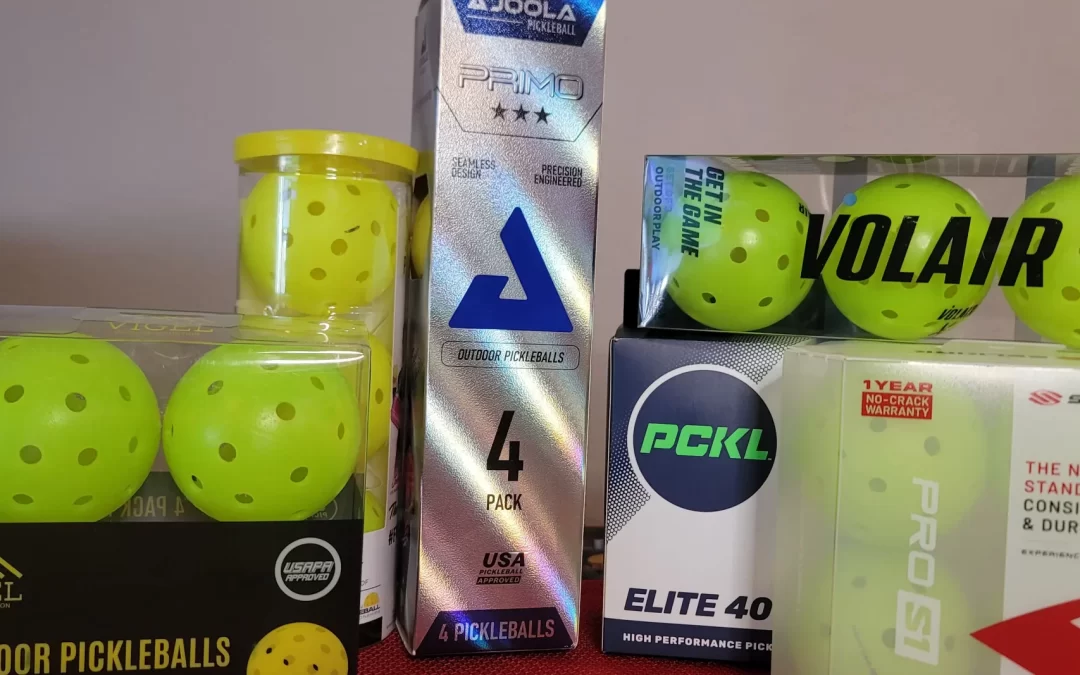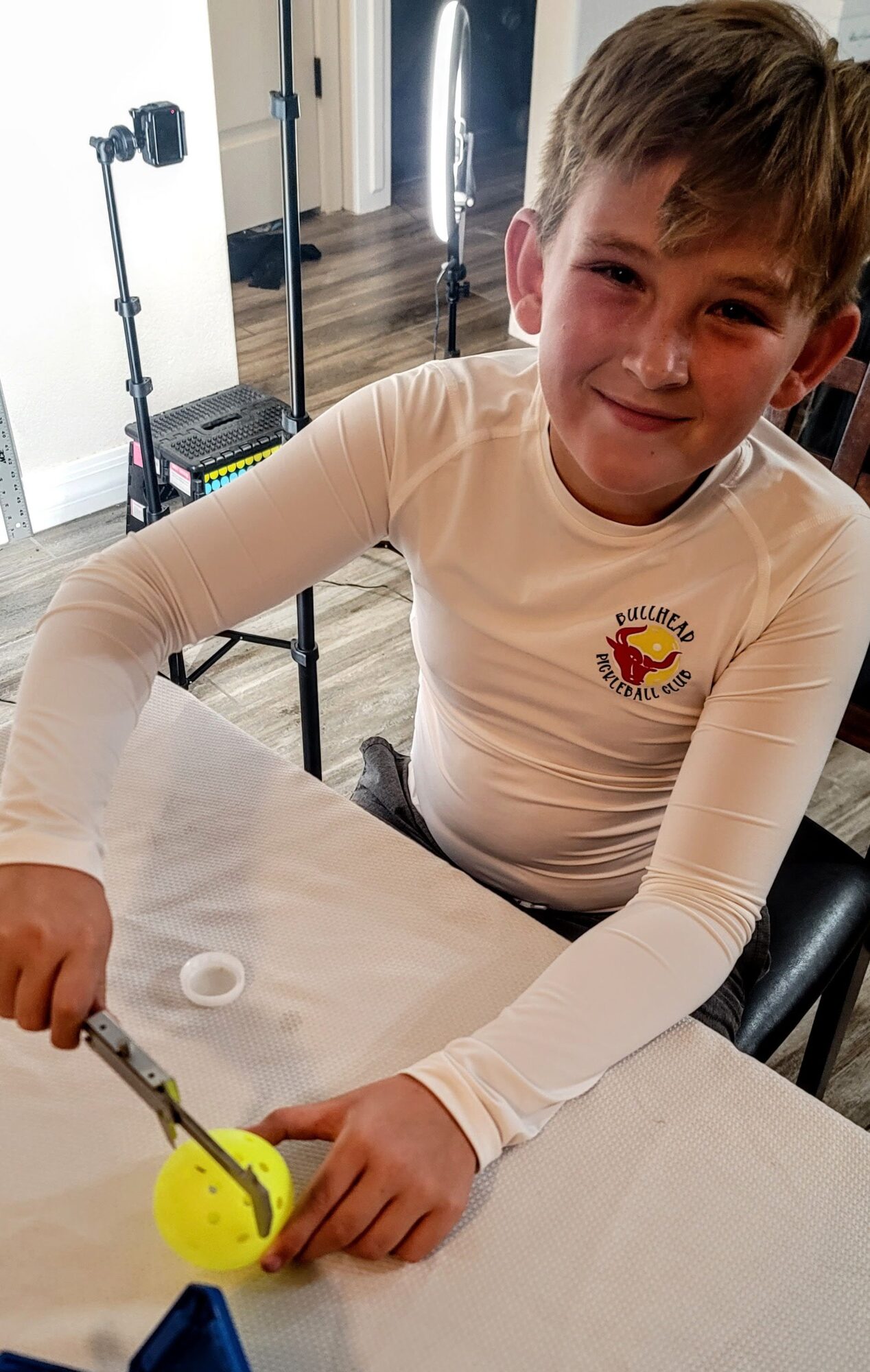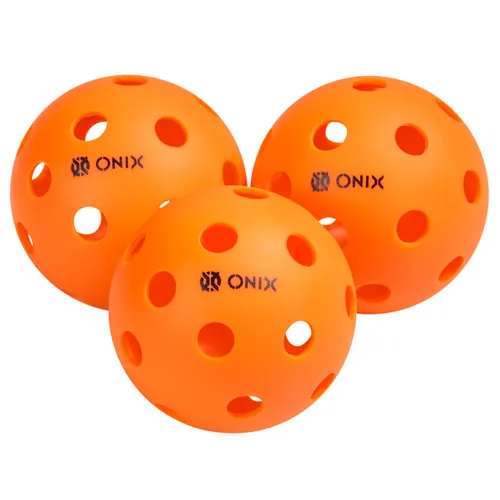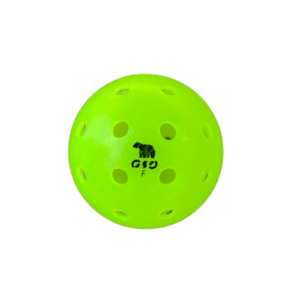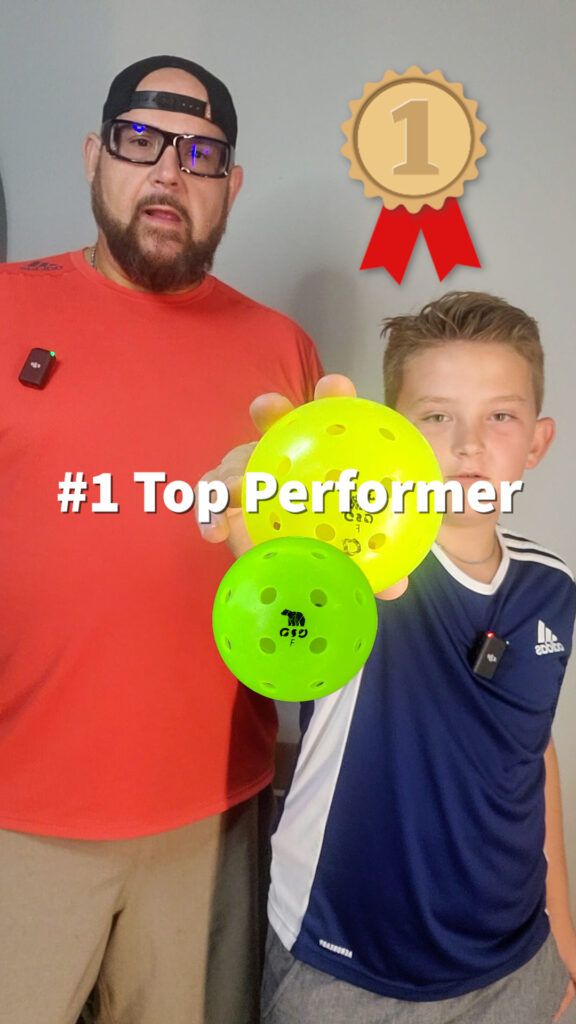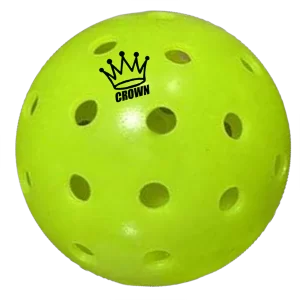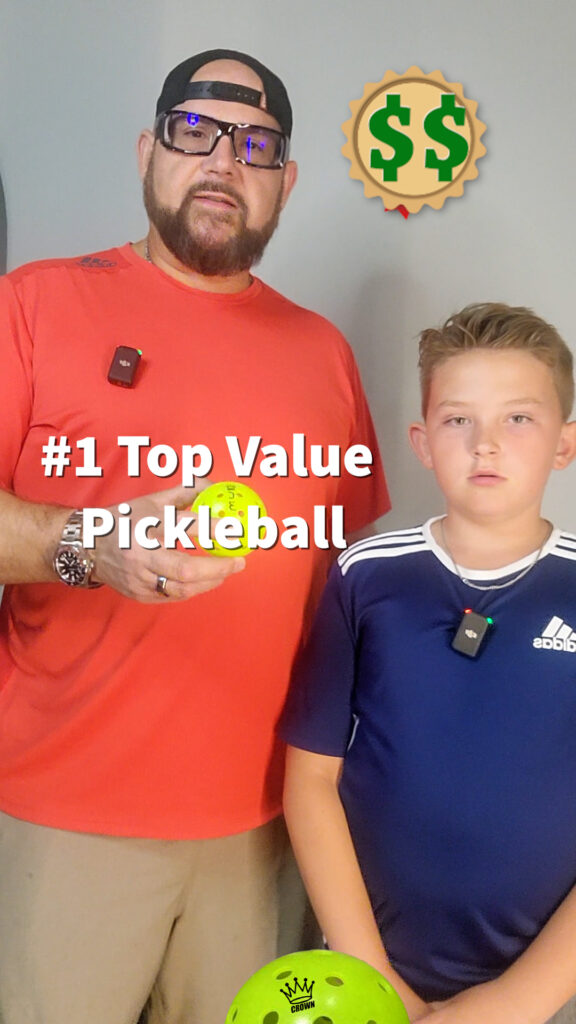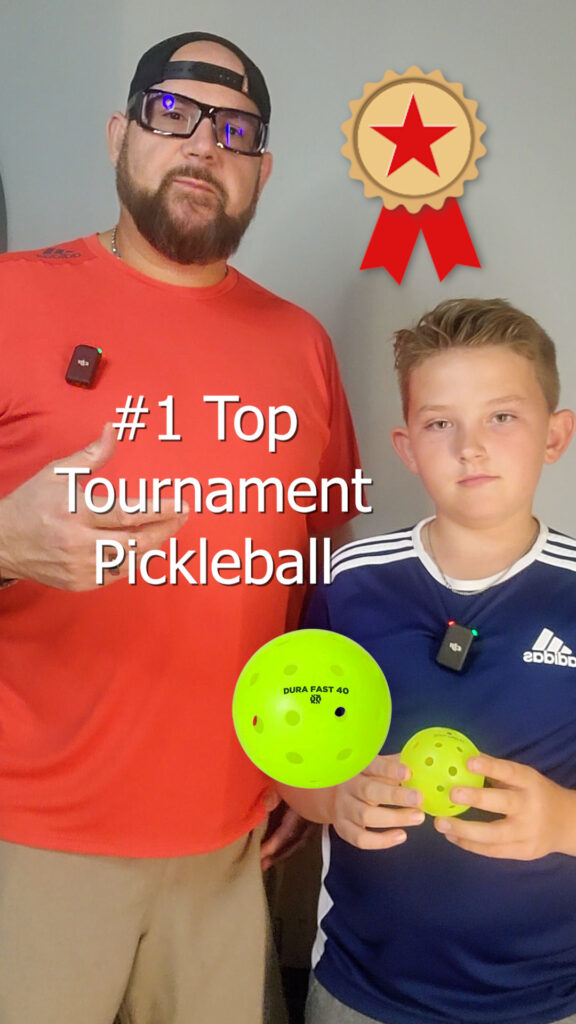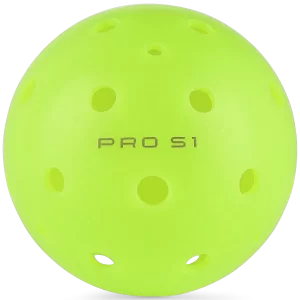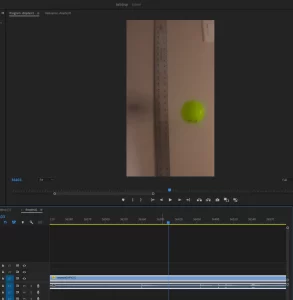Best Pickleball Balls
Find Answers
The questions we tried to answer are:
- Which brand makes a consistent product? How tight are the tolerances for mass, diameter, hardness, and how consistent will they perform in a drop test?
- Which brand makes the softest and hardest pickleballs?
- How does each brand’s balls respond to higher temperatures?
- Are there any balls that perform very similar to a Durafast 40 but are lower cost?
To tackle these questions we devised a testing regimen we figured would point us in the right direction.
Over the course of 5 days we measured 10 brands, using three balls per brand, and collected over 900 data points in an attempt to answer these questions.
Note the larger holes on these indoor pickleballs by ONIX.
Indoor vs Outdoor Pickleballs
We focused on outdoor pickleballs because we feel that players who are interested in buying the best pickleballs are looking at competetive play. Every major tournament uses outdoor pickleballs, even for their indoor tournaments.
The type of ball, indoor or outdoor, is determined by the playing surface, not whether the court is inside a building or not. Playing on a rough hard surface, like a tennis court or pickelball court, outdoor balls are recommended. Most major indoor tournaments will have temporary surfaces like a Pickleroll, that can be moved in for the event. These temporary pickleball courts are designed to simulate the feel of outdoor courts. As a result, outdoor pickleballs are specified as the tournament balls.
Indoor Pickleball Balls
Indoor pickelballs are designed to be used for playing surfaces like basketball courts, slick concrete, or lineoleum. Indoor balls typically bounce higher, so dinks are more easily attacked. Indoor pickleballs usually weigh less because wind is not a factor. They often have larger hole patterns, which can provide more shape on shots. However, because the outer surface of indoor balls is generally slicker, they are harder to hit with high spin.
In short, if you’re serious about competetive pickleball, only use indoor balls when the surface makes sense. Examples would be:
- wooden gym floor with taped court lines and temporary nets
- multi use surface that’s not specifically designed as a pickleball or tennis court.
- slick concrete pad in a warehouse used as a playing surface
AWARDS
#1 Overall Best Pickleball
OSO
The OSO pickleballs topped our charts. They offered a very consistent ball across all metrics. OSO pickleballs also performed most similar to Durafast 40 pickleballs but at a much more affordable price. This was reflected in our playtests, as these balls offered a premium feel and satisfying bounce.
| Consistency | ★★★★★ |
| Performance | ★★★★★ |
| Value | ★★★★ |
Best Value Performer Pickleball
Crown Pickleballs
These pickleballs had a similar feel to the OSO pickleballs. They are one of the most affordable pickleballs on the market. They perform well, but the manufacturing consistency could be improved. They were good enough for everyday use and felt good on the paddle. These balls have that soft, “gummy” feel, which feels good on the paddle and makes for a consistent bounce.
We feel that these will do well in our long term testing, and are looking forward to playing more games with the Crown pickleball.
If you buy these balls directly from Crown’s website you can get a 15% discount using JOP15 at checkout.
| Consistency | ★★★ |
| Performance | ★★★★ |
| Value | ★★★★★ |
Best Tournament Pickleball
Durafast 40
The Dura fast 40 sits at the top as the go-to ball for the PPA and MLP. This ball is hard, it’s fast, but it’s also expensive. We also know they are prone to cracking. Durafast 40s are also pretty expensive compared to the other balls in our experiment.
But this is the ball of the pros, and if you’re going to be playing competitive pickleball, this is the ball of choice.
| Consistency | ★★★ |
| Performance | ★★★★ |
| Value | ★★ |
New Entries
This section covers notable balls that were released after our initial testing. We put them through the same rigorous testing and provide our feedback.
UPDATE ON VULCAN PICKLEBALLS
We preorder 36 Vulcan pickleballs for further testing and to continue to familiarize ourselves with the ball for PPA Tournaments.
At the VEOLIA AUSTIN OPEN, Vulcan debuted a new formulation due to issues with the original ball.
These issues include:
- The ball becomes “out of round” after a short amount of play. The PPA mandated a new ball at the beginning of each game due to this issue.
- Inconsistent bounce – this may be related to the ‘out of round’ issue, as we found the balls to bounce relatively consistently in our testing. We may test some used balls to see if we can find the issue.
If you pre-ordered a batch of the new balls that were supposed to start shipping on March 18th, Vulcan has released this update via email:
…We are delaying release of the ball until early Summer – so we are refunding your money next week – then delivering your order for FREE as soon as the ball is available! This is our way of saying “Thank You!” for being among the first in the world to order the Vulcan VPRO FLIGHT Pickleball.After development and testing, we knew that the true proving ground of the Vulcan ball required actual play on the pro tour in a variety of conditions and settings. As we initiated full-scale production in January 2024, the play test date from the pro tour was doing great on tour early-on, then we began noticing some aspects of the ball that we could improve. To speed up these improvements, we immediately assembled a world-class team of resin specialists and consulting engineers to support our own engineers. We have continued to engage the world’s most elite pro players to help us study our concerns and reconcile them. This team has been working around-the-clock, and we are very close to being able to make the adjustments necessary to resume production.Vulcan’s commitment to innovation and excellence in the design of a pickleball is unprecedented in the sport. Our company is investing more in ball research and development every day, with a passion for producing the best ball for today’s game – and with a willingness to keep studying and innovating the ball as the game evolves over time.Thank you for your patience and understanding that we are processing an enormous number of refunds for our pre-orders. We will email every customer again once all refunds are complete, which may take our staff a week or two.
While we’re bummed we’re not getting our Vulcan order soon, we’re happy that Vulcan is taking ownership of the issue, communicating effectively to their customers, and ultimately doing what is best for the sport.
Vulcan Substitute
In the meantime, if you are looking for a ball to use to prepare for an upcoming PPA, our recommendation would be to use Durafast 40s. They are the next fastest ball to the Vulcan, and assuming they are going for similar characteristics in the new ball, the Dura40s will be the closest you can buy until the new balls ship.
Original content and testing about the first pass Vulcan pickleballs continues below, and we’ll update once we have more information and can do our own independent testing.
New Tournament Ball: Vulcan VPRO FLIGHT Outdoor PPA Tour Pickleball
We purchased a pack of 6 of the new ball from Vulcan. We also played with it all weekend at the PPA Masters in Palm Springs. After running the data we feel this is a quality ball that makes for a great replacement to the Durafast 40.
Notable Results:
New Champion – Energy Return. The Vulcan ball had the HIGHEST bounce tests results, beating out the Durafast40 by a mere 0.03 inches!
Hardest Ball – Vulcan VPRO edged out the CROWN pickleball in our duromter testing averging 49.94 and edging out the competition by 0.28 on the SHORE A scale.
The Vulcan ball peformed above average in terms of mass consistency and diameter variance.
In low quanities the Vulcan ball costs $5 which is good for tournament quality balls, but there are better options (Crown, OSO) if you want a quality ball but you’re not preparing for an upcoming tournament.
We did have one ball go out of round during play at the PPA Masters. Also the pros are replacing the ball every game. Durability may be an issue.
We’d recommend getting at least 6 Vulcan VPRO Flight balls to train for upcoming PPA tournaments, but for daily use, the OSO and CROWN pickleballs are still our top choice for casual play.
We’ll upload a playtest video soon so you can see these balls in action!
Vulcan Ball Controversy
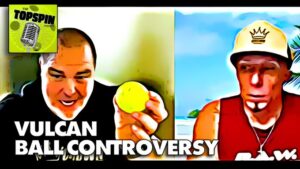
1. The manufacturing tolerances appear to be tighter than the set of Crown pickleballs we received.
2. The Vulcan balls are measurably harder in composition as show in the SHORE D durometer testing
3. The Vulcan balls had superior energy return compared to the Crown balls.
Our theory is that while they may be using the same manufacturer, Vulcan specified a different plastic composition to meet their needs. And perhaps the new plastic is easier to maintain consistency or the manufacturer has improved their process.
New Entry: Selkirk Pro S1
We received 12 balls from Selkirk to add to our test set.
We found the Pro S1 to be of hiqh quality, it had the most consistent mass of any brand tested. This speaks to tight manufacturing tolerences as the amount and density of material in each ball is the same.
The Selkirk ball also performed above average in diamter and roundness.
In terms of energy return and hardness, this ball performed similarly to the fastest balls in our test, and would make a good replacement for the Durafast 40.
In our playtest, the Pro S1 performed really well. It has a nice feel, consistent bounce, and just feels like a quality product overall.
Our only knock on the Selkirk ball is the price. Actually, the shipping. If you buy a pack of 4 on Selkirk.com, they cost $15, which puts them on par with the recommended balls in our testing. However the shipping is $10.72, which pushes the price per ball up to $6.43, making these balls nearly as expensive as Durafast 40s.
That being said, if you order paddles and apparel from Selkirk, you can add your balls to the order and take advantage of free shipping on larger orders.
Playtest Results
We have a warmup routine that we use every time we play. We did a quick version of this with each ball because the routine is repeatable so we can get a feel for each ball.
Franklin X-40
We play with this ball a lot on our courts. The Franklin x40 is soft and gets very soft at temperature. If you play with X-40s and then go to a tournament that uses Durafast 40 pickleballs, you’re going to have to adjust. Dinks are going to be more attackable because of the higher bounce.
Hands battles will be more difficult due to the higher energy return as well. Unless you have a tournament coming up that specifies a Franklin X-40 as the ball, we’d recommend training with a faster, higher-bouncing ball.
Volair
The Volair pickleball felt very similar to the OSO and Crown pickleballs in that it felt gummy or sticky on the surface. This ball exhibited a major wobble. Couple that with our testing results, we feel they have some work to do on quality control and consistency.
Vigel
The Vigel pickleball felt strange on the paddle, lacking the satisfying pop of a high-quality ball. Our Vigel ball in the playtest had a wobble as well. We would not recommend using these pickleballs.
Durafast 40
Best ball for tournament play. This ball plays fast and hard. It holds up decently in heat and the quality control is pretty good. As the official pickleball of the PPA and MLP, this is the gold standard against which all other balls are measured. The only problem is the price.
Crown
These balls feel pretty good. They felt similar to a Durafast 40 and had a quality feel. We feel confident we could play with these regularly and still adapt well to tournament balls.
OSO
These felt similar to the Crown and seemed to have similar pop as a Durafast. We’ve had one OSO ball that we’ve used off and on for months and it’s still usable. OSO definitely makes a quality ball.
PCKL
This ball was so dead. It barely bounced. The only thing we’d recommend this ball for is a dinking tournament. Because of the extremely low bounce, it would be very hard to attack. Or if you want to pull a fast one on the bangers in your playgroup. Whip this ball out and watch them drive everything into the net.
A11N
These are not quality pickleballs. They look like a Durafast on the website, but they’re extremely soft. The sound when they hit the paddle face is not the satisfying “POP” we’re feeling with the higher-quality balls. Would not recommend it.
GAMMA
These pickleballs feel like plastic toys. Or like airsoft pellets. They’re very light and the wind blows them around a lot. We would not recommend these unless you’re a very novice player with no aspirations of improving. They’re like the quality of balls you’d expect if you buy a four-pack of paddles at Big 5 and the package comes with three balls. Would not recommend these balls.
Joola
These pickleballs bounced very inconsistently. Sometimes they would bounce normally, other times they were dead. Would not recommend it.
Selkirk Pro S1
Solid ball with a quality feel. Consistent bounce and good spin. If you’re a Selkirk fan, add some Pro S1s to your order to get the free shipping.
Vulcan VPRO Flight
The new ball from Vulcan replaces the Durafast 40 as our top Tournament ball. Fast ball of high quality. Color change is a big improvement over the old pale yellow tournament balls from Durafast.
How We Selected the Brands and Balls
First off we know that Franklin X-40s are popular in amateur tournaments, and can often be found on our home courts. We also know that Durafast 40s are the choice of the PPA and MLP. So these two balls were selected as the benchmark against which the other brands would be measured.
We selected the OSO pickleballs on recommendation from the Pickleball Studio and had some on hand. We felt these were pretty good balls and wanted to see how they stack up against the competition.
As fans of the King of the Court podcast, we decided to give Crown pickleballs a shot too, as the price point seemed favorable.
We also selected the Joola pickleballs as we know they make quality paddles and wanted to see how they’d fare in the competition.
For the rest, we searched for “Outdoor Pickleballs” on Amazon, and picked another 5 balls that looked like similar builds to the Franklin X-40 or Durafast 40.
Pickleball Costs
We looked at the pricing from the manufacturer when possible and chose the smallest order size and the cheapest shipping option. Here’s the cost breakdown.
Notes: Vigel requires Amazon Prime for shipping. Crown currently offering free shipping with promo code.
Tests & Measurements
For all tests we selected 3 balls from each brand and labeled them so we could track the data over time.
Mass
We simply measured each ball using a scale that is accurate to 1/100th of a gram. Chart shows the average of the 3 balls from each brand.
We also looked at the max and minimum mass to make sure they are in spec. All balls were above the minimum mass of 22g, but a few were slightly on the heavy side, especially the tournament balls, the Franklin X-40 and the Durafast 40.
Finally we looked at the variance in mass to see which brand had the most consistent mass. (Lower number is more consistent).
Diameter
What is the diameter specification for USAP certified pickleball?
The ball shall be 2.87 inches (7.29 cm) to 2.97 inches (7.54 cm) in diameter. The maximum out-of-round diameter variance shall not be greater than +/-0.020 inch (0.51 mm). source
In order to determine diameter measurements, we took three readings, two perpendicular, one offset 45°,45° for each ball. First, we looked at the average diameter to answer the question:
Who Makes the Biggest Pickleball?
In our testing, PCKL pickleballs had the largest average diameter at 74.78mm.
We also looked at the maximum “out of round” and average for each brand. To calculate this we took the largest diameter of a ball, minus the smallest measurement for that ball. We then took the largest out-of-round result from the 3 balls in the brand set.
We can see that at least one ball in the set failed for the following brands: Franklin, Vigel, Crown, & A11N. On average, most of the brands are compliant with exception of the Franklin balls.
Drop Test
In order to determine the amount of energy a pickleball returns, the USAP defines the drop test as:
The ball shall have a bounce of 30 to 34 inches (76.2 to 86.4 cm) to the top of the ball
when dropped from a height of 78 inches (198.1 cm) onto a granite surface plate that is a minimum of 12 inches (30.5 cm) by 12 inches (30.5 cm) by 4 inches (10.2 cm). The test is to be performed at an ambient temperature of 70 degrees F plus or minus 5 degrees F.
We took two measurements from each drop in an attempt to determine energy return. First, we set up a yardstick in the background and filmed all drops with a 120fps video camera. We also used the audio track to measure the time (in frames) between the first bounce and the second bounce. Longer times would indicate more energy return.
Using the data from the frame results show similar trends, but slight differences. We think that this is because the frame count can be off by ±1 frames. Which is roughly 2% of the drop time.
Finally, we wanted to see how consistently different balls from the same brand performed in the drop test.
Hardness
We used a SHORE D durometer to take 3 readings per ball, and 5 second creep time to see if the hardness correlated to higher bounce heights.
The USAP spec for hardness is as follows:
The ball shall have a hardness of 40 to 50
on a Durometer D scale at an ambient temperature of 70 degrees F plus or minus 5 degrees F.
The USAP no longer uses this measurement but hardness is measured as a collary data point.
An interesting finding is that the Crown ball consistently rated the highest on the durometer tests, but came in 3rd in the drop test. We think that is because the outer surface feels somewhat gummy, but the layer underneath is very hard. We’d love to do a compression test to learn more.
Hardness Variance
First, we looked at the Durometer measurements across the entire set to determine material consistency and quality:
Next, we looked at each brand’s most consistent and least consistent ball.
The Gamma and Volair brands’ best balls were less consistent than the worst balls from Oso and Durafast.
Temperature Resiliency
We live in a hot desert climate, so performance at temps over 90°F is important for choosing the right pickleball.
We heated all balls over 90°F and re-tested the drop test and durometer readings. We then look at the differences.
We also looked at the amount of height loss as a percentage of the 70°F drop height.
We also took hot durometer readings to see if the loss of bounce was reflected in the durometer readings:
Test Procedures
Mass
This one is pretty simple. We placed a bottle cap on top of the scale so the ball wouldn’t roll around. We then zeroed the scale and took the measurement in grams.
Diameter
First, we took a diameter reading with the digital caliper where the measurement crossed the logo on the ball. We then rotated the ball 90° so the logo was still under the caliper face, just taking the other hemisphere’s diameter. Next, we rotated the ball approximately 45° on both axes in order to get a 3rd unique diameter measurement.
Drop Test
We left the camera running for the entire drop. We had a spot marked on the wall at 78″ off the ground. The drop surface was a hard tile floor. We didn’t have a sufficient granite surface to use, but feel the results are useful for the purposes of comparison. Each ball was dropped 3 times and the brand, ball marking, and drop number were called out for each drop.
Using Adobe Premiere Pro, we could go through the footage frame by frame (@120FPS resolution). We find the maximum rebound in height by looking at the video. We also recorded the number of frames between the first and second bounce by using the audio waveform on the video timeline.
Hardness
We took three durometer measurements. One near the logo, the second on the opposite side of the ball, and another rotated 45°,45° for a third unique measurement. We used a 5-second creep time to allow the durometer to settle.
Heat Resiliency
We placed all the balls in a box outside at ambient 105°F. We took a temperature measurement outside, quickly brought the ball in for the test, and recorded an exit temperature to ensure all balls experienced similar heat conditions. While not ideal, this allowed us to perform the tests while avoiding heat stroke.
Testing Improvements
Compression Testing
We would love to do compression testing, but the test rigs cost several thousands of dollars. This is important because we can see balls with “harder” materials on the durometer scale don’t necessarily bounce as high (Crown vs. Dura). If you imagine a hollow steel ball vs. a ball made of superball material, you’d expect the steel ball to register a higher durometer reading, but the superball to bounce higher.
Sample Size
A larger sample size of balls and brands would be interesting, but the costs stack up as the data set expands.
More Rigorous Testing
We’d also improve the testing by standardizing the testing methodology:
- Machine-operated durometer testing
- Mechanical drop rig rather than dropping the ball by hand
- Faster frame rate camera to increase frame time accuracy
- Better temperature controls
Future Tests
In order to test durability, we’d need to come up with a standardized test so that all brands experience the same conditions. This would probably require a ball machine and simulated strokes. Otherwise, the data would be too volatile to offer any insights into durability.
We attempted to test the max velocity of each ball using a relatively inexpensive radar gun. We found that the radar gun had a difficult time tracking the ball consistently. We also determined that the input to the test (i.e. our swing, impact point, and paddle angle) was too variable to provide any meaningful data. As a result, this test was scrapped.
Test Equipment
Measurement | Product | Image |
Mass |  | |
Diameter | Jivarry model Kachi*steel452 Precise Digital Caliper Specifications Measuring range: 0-150 mm / 0-6 in Resolution: 0.01 mm/0.0005” Accuracy: ±0.02 mm/0.001” |  |
Hardness | Measuring Range:0~100 HD, Indentor Running : 0-2.5mm |  |
Temperature | Etekcity Infrared Thermometer Gun 1080 Temperature range from -58°–1130°F / -50°–610°C in 500 ms |  |
Height | ACE Hardware Steel Measuring Stick | Looks like a ruler, only longer, and made of steel. |
